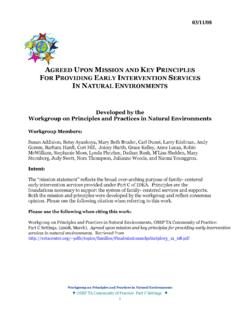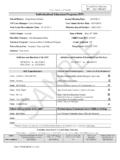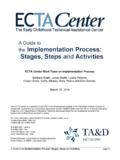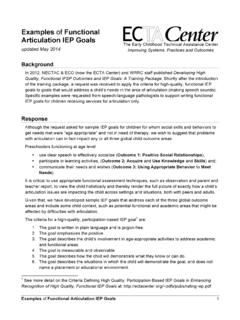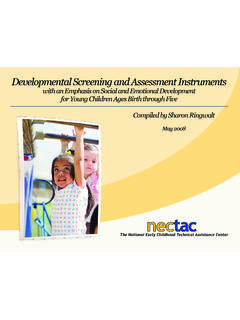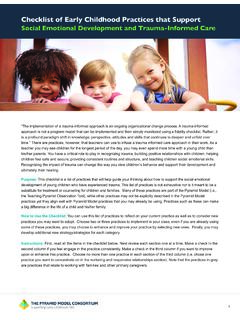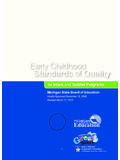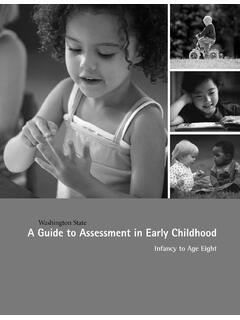Transcription of Quality Indicators of Inclusive Early Childhood Programs ...
1 Quality Indicators of Inclusive Early Childhood Programs /Practices A Compilation of Selected Resources September 2010. The NECTAC Preschool TA Team Debbie Cate Martha Diefendorf nectac The National Early Childhood Katy McCullough Mary Peters Technical Assistance Center Kathy Whaley The National Early Childhood Technical Assistance Center (NECTAC). is a program of the FPG Child Development Institute of The University of North Carolina at Chapel Hill September 2010. This resource is produced and distributed by the National Early Childhood Technical Assistance Center, funded through cooperative agreement number H326H060005 from the Office of Special Education Programs , Department of Education. Opinions expressed herein do not necessarily represent the Department of Education's position or policy.
2 NECTAC is committed to making the information it disseminates fully accessible to all individuals. If you require any of this information in an alternate format, please contact us at the address below. Additional copies of this document are available at cost from NECTAC. A complete list of NECTAC. resources is available at our website or upon request. Please cite as: Cate, D., Diefendorf, M., McCullough, K., Peters, M. L., & Whaley, K. (Eds.). (2010). Quality Indicators of Inclusive Early Childhood Programs /practices: A compilation of selected resources. Chapel Hill: The University of North Carolina, FPG Child Development Institute, National Early Childhood Technical Assistance Center. Photos: Alex Lazara For more information about NECTAC, please contact us at: Campus Box 8040, UNC-CH.
3 Chapel Hill, NC 27599-8040. 919-962-2001 phone 919-966-7463 fax email web Project Director: Lynne Kahn Project Officer at OSEP: Julia Martin Eile Quality Indicators of Inclusive Early Childhood Programs /Practices A Compilation of Selected Resources Table of Contents UNDERSTANDING INCLUSION .. 3. USING THE COMPILATION .. 4. Quality INCLUSION CONSIDERATIONS .. 5. Preschool Assessment of Classroom Environment Scale Melinda Raab & Carl Dunst, 6. Choosing Quality Child Care for a Child with Special Needs NACCRRA, Child Care Aware, 7. DEC Recommended Practices .. 8. Questions to Consider in Universal Designed Learning (UDL) Observations of Early Childhood Environments Robin Cunconan-Lahr & Susan Stifel, 9. Quality Inclusive Early Childhood Programs : 10 Things to Look For Donna Nylander, 2009.
4 10. Preschool and Kindergarten Inclusion Readiness Checklist Amy Watson & Rebecca McCathren, 2009 .. 12. CLASSROOM OBSERVATION RATING TOOLS .. 13. ITERS-R: Infant Toddler Environment Rating Scale, Revised Thelma Harms, Debby Cryer & Richard Clifford, 14. ECERS-R: Early Childhood Environment Rating Scale, Revised Thelma Harms, Debby Cryer & Richard Clifford, 14. Inclusive Classroom Profile (ICP). Elena Soukakou, 15. Classroom Assessment Scoring System (CLASS ). Robert Pianta, Karen LeParo & Bridget Hamre, 2008 .. 16. The SpeciaLink Early Childhood Inclusion Quality Scale Sharon Irwin, 2009 .. 17. What to Look For In a Quality Inclusive Prekindergarten (Pre-K) Classroom Technical Assistance and Training System (TATS), 2008-2009 .. 18. NECTAC Quality Indicators of Inclusive Programs -1- September 2010.
5 INDIVIDUAL CHILD-FOCUSED CONSIDERATIONS .. 23. Playmates & Friends Questionnaire for Teachers Barbara Davis Goldman & Virginia Buysse, 2005 .. 24. Members of the Class: Teachers Guide Head Start Center for Inclusion, 25. CARA's Kit: Checklist of Priorities and Concern Suzanna Milbourne & Philippa Campbell, 26. COLLABORATIVE Inclusive PRACTICES .. 27. PTAN Partnerships for Inclusion Self-Assessment Tool New Hampshire, 28. Preschool Inclusion: Self-Evaluation Tool Pennsylvania, 28. Inclusion Planning Checklist: Center-Based Early Care and Education Programs Special Quest, 28. Quality RATING AND IMPROVEMENT SYSTEMS (QRIS) ..29. QRIS Quality Standards National Child Care Information and Technical Assistance Center, 30. Why Program Quality Matters for Inclusion Virginia Buysse, Tracey West & Heidi Hollingsworth, 30.
6 Compendium of Quality Rating Systems and Evaluations Prepared for the Office of Planning, Research and Evaluation of the Administration for Children and Families, 2010 .. 31. NECTAC Quality Indicators of Inclusive Programs -2- September 2010. UNDERSTANDING INCLUSION. What do we mean by inclusion? The definition, values, and views related to Early Childhood inclusion have varied over time and across states and Programs . The Joint Position Statement (2009) of the Division for Early Childhood (DEC) and the National Association for the Education of Young Children (NAEYC) highlights three key principles of Early Childhood inclusion to be utilized collectively to identify high Quality Early Childhood Programs and services. Access, participation, and supports are all necessary to ensure that the needs and priorities of infants and young children with disabilities and their families are met in Inclusive opportunities.
7 Each element is defined within the Joint Position Statement: Access Providing access to a wide range of learning opportunities, activities, settings, and environments is a defining feature of high Quality Early Childhood inclusion. Participation Some children will need additional individualized accommodations and supports to participate fully in play and learning activities with peers and adults. Supports An infrastructure of systems-level supports must be in place to undergird the efforts of individuals and organizations providing Inclusive services to children and families. The DEC/NAEYC joint statement has been validated and embraced by the Early Childhood community and provides a lens for considering Indicators of Quality settings and practices. How do we determine Quality ?
8 There are several areas of focus and many elements that contribute to program Quality , including the organization of physical space, appropriate and adequate supply of materials, teacher qualifications, programming variables, instructional strategies, collaboration among team members and families, as well as individualization and adaptations within daily routines. Ideally, Quality Inclusive systems are developed intentionally and planfully' from the start rather than after other aspects of the system are already in place. However, in many instances, existing systems and Programs need to make changes to be Inclusive of all children. A number of tools and resources exist which aim to guide Programs in implementing high Quality inclusion practices. High Quality Early care and education can provide many benefits to young children, both with and without disabilities.
9 Inclusion alone does not guarantee desirable outcomes for children with disabilities. Two conditions, a high Quality environment and supports for classroom staff, must characterize all Inclusive Early Childhood settings to ensure desirable outcomes for all children, especially children with disabilities (Wolery, 2003). Overall Quality measures of inclusion based on an average rating of a program, classroom or setting may not reflect the actual inclusion experience or appropriateness for individual children. Multiple measures, along with individually relevant information and periodic review, may be the best way of determining the Quality of inclusion experiences and opportunities for individual children. Consideration of the actual inclusion experience of individual children, their families and peers, and the careful review of items listed within tools and resources must be made.
10 Program evaluation and review of practices reveal that no single tool is able to assess the three aspects of Quality as defined by the Joint Position Paper (access, participation, and supports). Sources: Joint Position Statement (2009) of the Division for Early Childhood (DEC) and the National Association for the Education of Young Children (NAEYC): Division for Early Childhood DEC: National Association for the Education of Young Children NAEYC: Wolery, Mark (2003): NECTAC Quality Indicators of Inclusive Programs -3- September 2010. USING THE COMPILATION. Available resources and Indicators of high Quality Inclusive practices are presented in this compilation. Assembling many different resources in one place allows for easy comparison of potential Indicators of Quality .


